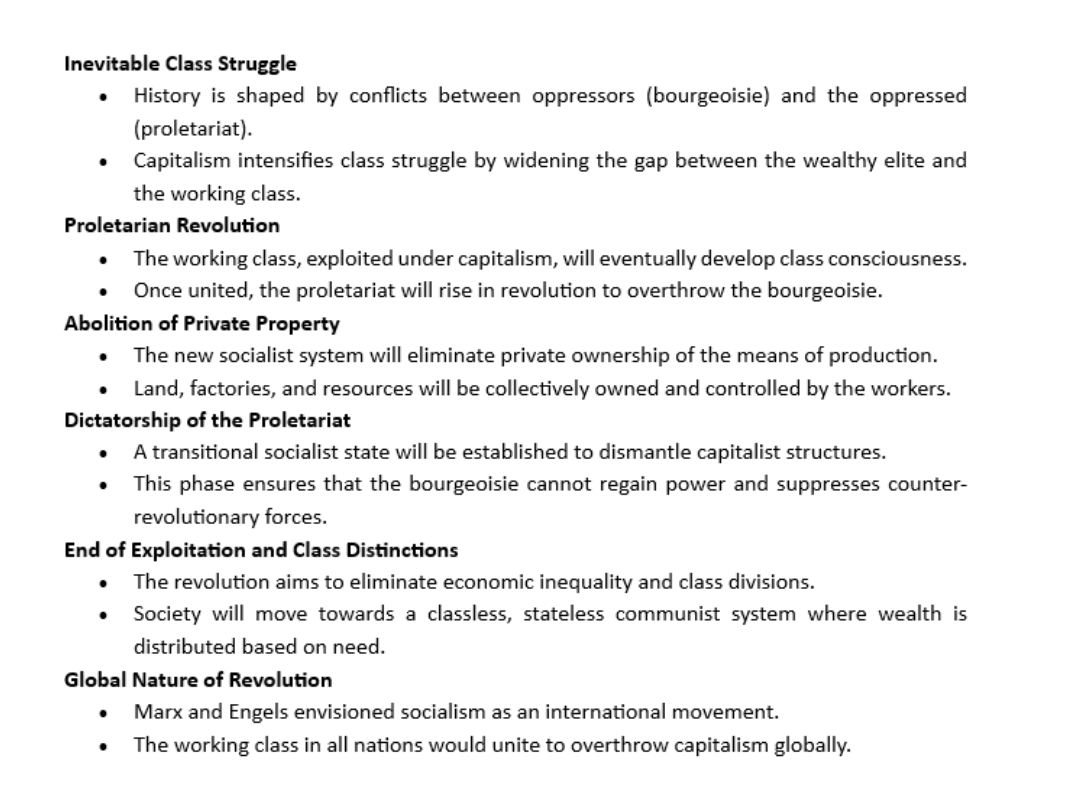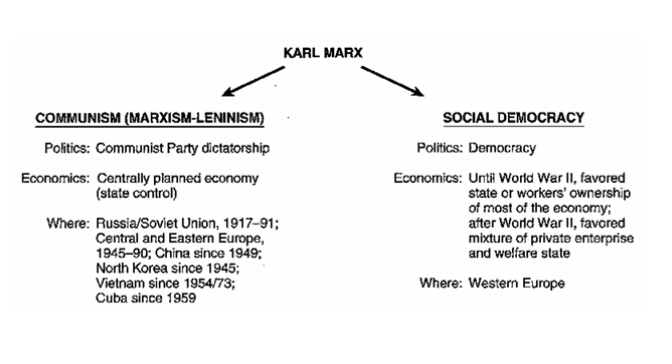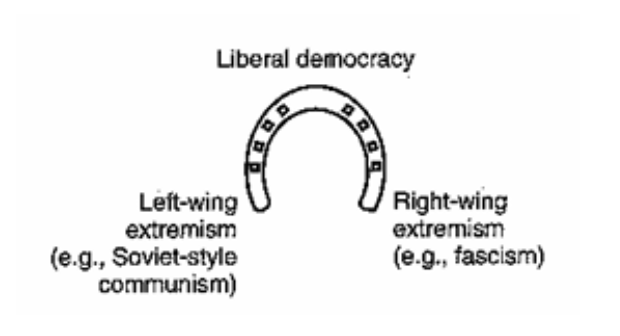Chapter 13: Ideology (Sodaro)
1/54
There's no tags or description
Looks like no tags are added yet.
Name | Mastery | Learn | Test | Matching | Spaced |
|---|
No study sessions yet.
55 Terms
what is ideology
Ideology is a coherent set of ideas that typically includes:
1. A theory about political relationships and the role of the state
2. A notion of what constitutes political legitimacy and the highest political values
3. An action program indicating the goals.ideals, policies, and tactics to be pursued by the state, political elites, and the masses
Why is Ideology important?
Ideology provides a cohesive worldview to individuals and nations, allowing them to make value of political events, institutions, and decisions.
Ideologies can unite people around shared principles, but they can also be sources of division when competing ideologies clash.
Liberalism
Liberalism essentially means democracy. In its
oldest and broadest definition, liberalism refers to a system ofgovernment that guarantees liberty. In the earliest manifestation of
liberalism it posed a direct challenge to government by absolute
monarchs and aristocracies, expressing the basic idea that the
power of the state should be limited and that certain freedoms
should be granted to the people by law.
Social Liberalism [US]
Social Liberalism means active government intervention in the economy and society for the purpose of promoting economic growth, community welfare, and social justice.
Conservatism [US]
Conservatism in the US is the heir to the classical
liberal tradition of minimal government interference in
the economy.
Liberalism and Conservatism in the around the World (two meanings outside the US)
First meaning: Liberalism favors political and economic freedom as opposed to authoritarianism and socialism.
Second meaning: Liberalism, particularly in Europe
and Latin America, is often associated with center-left policies that emphasize social justice, government intervention in the economy, and the welfare state, aligning more closely with what Americans call progressivism or social democracy.
Conservatism also assumes different meanings in different contexts
●First meaning: Conservatism means resistance to
any kind of change unless absolutely necessary.
●Second meaning: Today;s conservatives favor
democracy and the market economy.
Socialism
Socialism emerged as a reaction to the excesses of the
industrial revolution and free enterprise.
Socialism in its original nineteenth century conception,
therefore was understood as a political and economic
system in which private enterprise is abolished and replaced
by some form of common ownership of factories, farms, and
other productive enterprises.
free enterprise system
Capitalism
having common ownership of the economy
Communism
Utopian socialists
term that derived from Sir Thomas More’s design for an ideal society in his book Utopia.
Marxism
A social, economic, and political philosophy
developed by Karl Marx and Friedrich Engels,
centered on the theory of historical
materialism and class struggle, arguing that
history is driven by economic forces and the
conflict between social classes, ultimately
leading to a communist revolution.
Hegel's dialectic
is a philosophical
framework that describes how ideas
and concepts evolve through a
process of thesis, antithesis, and
synthesis, leading to a higher level of
understanding.
marx vs hegel
hegel -Philosophical Idealist who believed in spiritual forces like a deity.
marxist - philosophical materialist who rejected spiritual essences.
Alienation
Private property, in particular, stood out as a
principal cause of “Alienation” which Marx
described as “the self-estrangement of man
from himself.
”
who wrote Communist Manifesto.
Marx refined his central notion that the
principal motive forces in society and politics
are economic in nature. He was joined by
Friedrich Engels in this endaevor.One of their
famous tracts was the Communist
Manifesto.
Marx developed two critical ideas that defined
what dialectical materialism meant in
practice.
1. Economic relations condition everything else that happens on human affairs.
2. Class conflict
Bourgeoisie
Bourgeoisie refers to the capitalist class in
the industrializing countries. The term derived
from the term bourg, the old German and
French word for town or city.
proletariat
Marx used proletariat when referring to the
industrial working class.
-
Proletariat are workers or
working-class people, regarded
collectively.
Monopolization
The most successful capitalists drive their competitors out of business, a process Marx called Monopolization.
Lumpenproletariat
The proletariat swell beyond the
capitalist system’s ability to employ them.
The unemployed grow into a vast “reserve
army of the proletariat” that Marx called
Lumpenproletariat, the “proletariat in rags.
”
Marx’s view, electoral democracy in capitalist societies
In Marx’s view, electoral democracy in
capitalist societies is a sham that holds out
no hope for the working class; it is nothing
more than a “bourgeois democracy,” thoroughly manipulated by the capitalist class
for it;s own benefits.
The Socialist Revolution in the Manifesto

Scientific Socialism.
Scientific Socialism. In the Manifesto, Marx
and Engels proclaimed that the destruction of
capitalism and the victory of the proletariat
were inevitable
Soviet-Style Communism
Communism came to Russia as a well
orchestrated coup d’etat engineered by a
highly centralized political party, the
Bolsheviks.
Leninism
The key idea of Leninism is the primacy of the Communist party.

Social Democracy
Social Democracy is a combination of
economic socialism and political democracy.
Fascism
In most instances, fascism is a response to a specific
combination of problems that face certain societies at a
particular juncture in their historical development. Ethnic
diversity and long term unemployment are typical of the
problems that spark neo-fascist resentments, particularly
among poorly educated white males
Fascism consist of the following four features:
Hypernationalism
Racism
Totalitarianism
Mass MobilIzation Through Propaganda and
Coercion
II. Religion as political Ideology: Islam
Islam has emerged as the most politically active religious
force in the contemporary world.
Origins
●Muhammad's Death and the Succession
Crisis
The First Caliphs:
A group of Muhammad's
companions chose his close friend Abu Bakr
as the first caliph (khalifa), meaning
"successor" or "representative.
" However,
some believed Muhammad had designated
his cousin and son-in-law Ali as his rightful
heir.
The Sunni-Shia Split:
The disagreement over succession led to a major schism within Islam. Those who supported Abu Bakr and the subsequent caliphs became known as Sunnis (meaning "followers of the Sunna," or tradition of the Prophet). Those who believed Ali was the rightful successor became known
as Shia (or Shiites), meaning "partisans of Ali. "
The Abbasid Caliphate
The Abbasid dynasty, claiming descent from Muhammad's
uncle, eventually overthrew the Umayyad
caliphate. However, they also turned against
the Shia, leading to further conflict.
Islam as a Way of Life
Islam is presented
as an all-encompassing way of life, where
religion and politics are intertwined. The
Islamic community (ummah) is both religious
and political, governed by Islamic law
(sharia).
Theocracy vs. Reality
The original Islamic
doctrine suggests a theocratic government
with Allah as the source of legitimacy.
However, the vast expansion of the Islamic
world led to diverse states and empires ruled
by Muslims who were not religious
authorities. This created a tension between
the ideal of a theocracy and the practical
realities of governance.
Sunni and Shia Differences
The excerpt
contrasts the Sunni and Shia clergy
structures. Shia clergy has a tiered hierarchy
with "grand ayatollahs" at the top, while Sunni
clergy is less structured, allowing for more
flexibility in religious and political doctrine.
Traditionalism
Emphasizes peace and
coexistence, but views Islamic law as binding
on all Muslims, even though interpretations
may differ.
Modernism (Reformism)
Advocates for the
separation of religion and state, with Islamic
law limited to personal and religious matters.
Fundamentalism (Islamism)
Favors a state based on a strict interpretation of Islamic law,
including harsh punishments.
what is the most prominent general school of Sunni
fundamentalism
The most prominent general school of Sunni
fundamentalism is Salafism, which calls for a
return to the "pure" form of Islam practiced by
the early generations of Muslims.
Wahhabism
Wahhabism, founded by Muhammad Ibn
al-Wahhab, emphasizes a strict interpretation
of the Quran and Islamic law.
The Arabic word jihad means…
●Jihad of the heart: The internal struggle
against sin.
●Jihad of the tongue: Speaking out against
evil and advocating for good.
●Jihad of the sword: Physical struggle,
including warfare.
who issued a fatwa
Osama bin Laden issued a fatwa in 1998
calling for Muslims to kill Americans and
seize their wealth. This fatwa was considered
an extreme interpretation of jihad by most
Muslims.
How does islamic authorities view jihad
Most Islamic authorities do not view jihad as
justifying indiscriminate terrorism against
non-Muslims.
jihadists
The term "jihadists" is used to describe
Islamic militants who promote violence
against non-Muslims.
Root Causes of Suicide Terrorism:
1. Robert Pape's Argument:
2. Role of Religion:
Islamic exceptionalism
(the idea that Islamic countries cannot build democracies)
will likely continue.
The Left-Right Spectrum
Left: Utopian socialism, anarchism, Marxism,
Soviet-style communism, social democracy,
social-welfare liberalism.
Right: Liberal democracy, democratic
conservatism, monarchy, fascism, religious
regimes.

The Political Horseshoe
the extreme left and extreme right share similarities and may converge.

Daniel Bell's Argument
Daniel Bell's
hypothesis that the era of intense ideological
conflict was ending due to post-World War II
economic changes in advanced capitalist
countries.
Post-Industrialism
Post-Industrialism: Bell argued that the shift
from industrialism to a post-industrial society
was undermining the basis of the
capitalist-socialist ideological clash.
Evidences supporting the Hypothesis
A. Fall of Soviet-Style Communism
B. Economic Liberalization in Former
Communist Countries
C. Economic Reforms in Developing
Countries
Evidence Against the Hypothesis:
A. Continued Ideological Opposition
B. Russia's Uncertain Path
C. China's Authoritarian Model
D. Muslim Ideological Alternatives
E. Potential for New Ideologies
"Wave" of Democracy and Markets:
There seems to be a trend towards
democracy and market-oriented
economies globally.